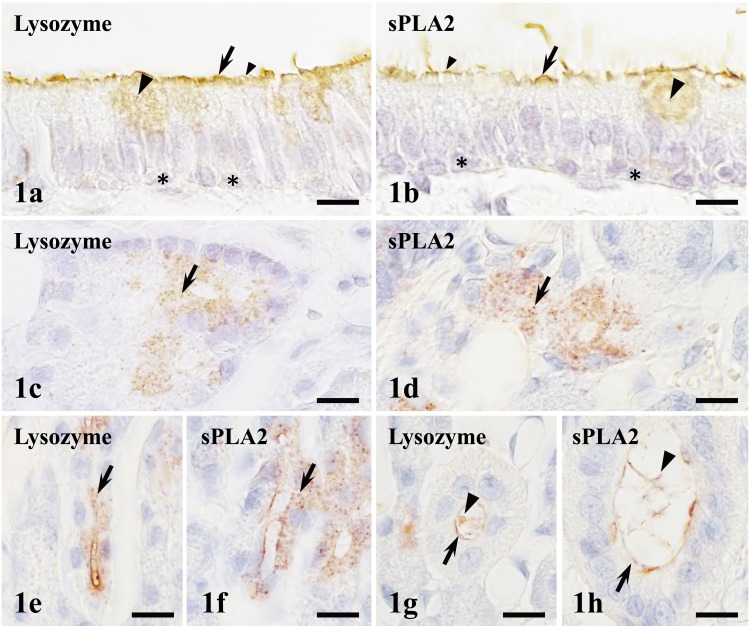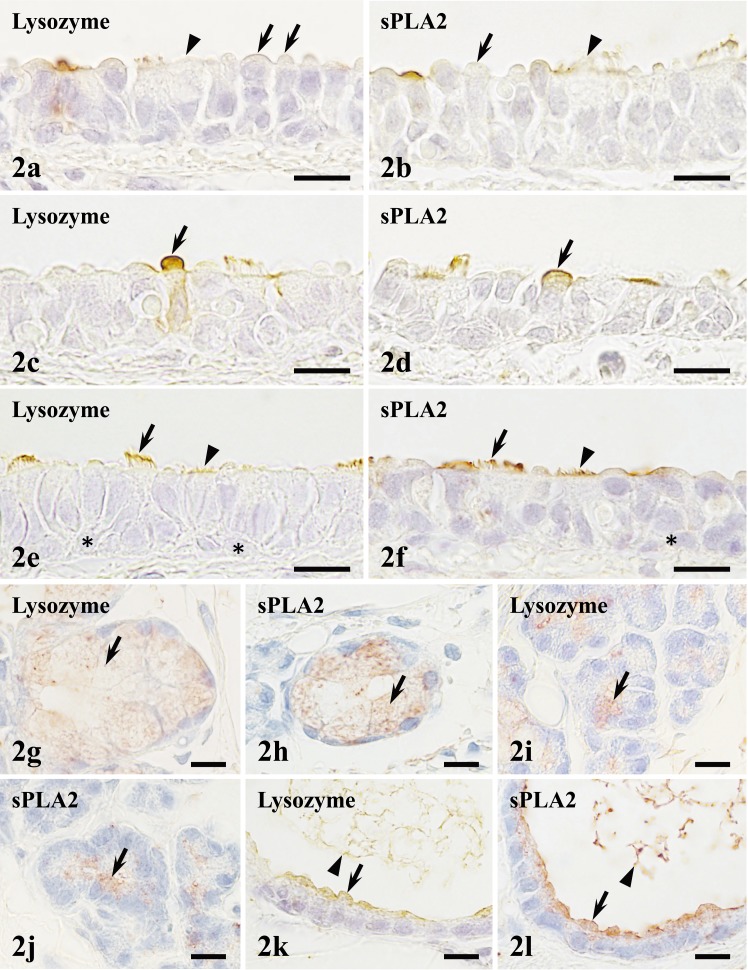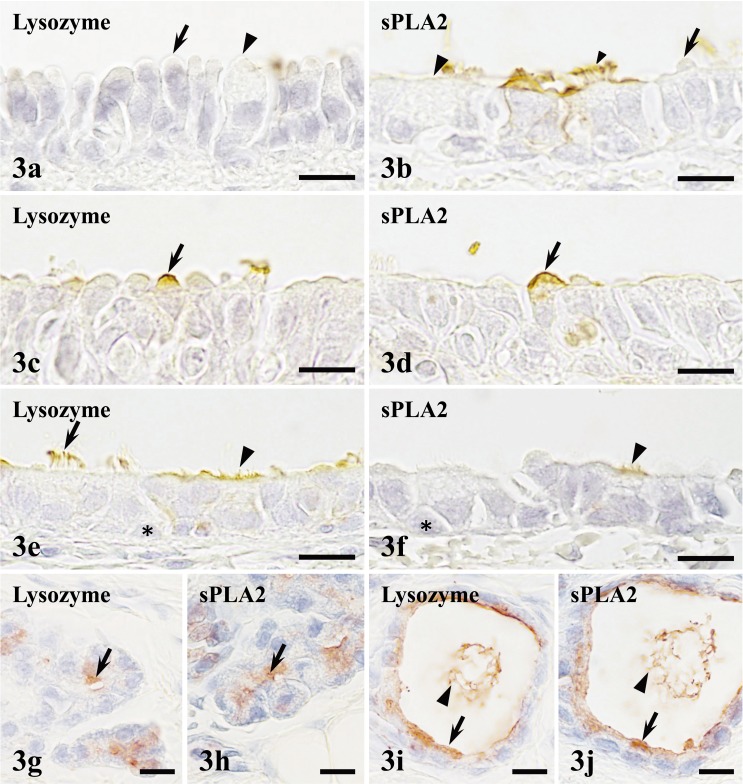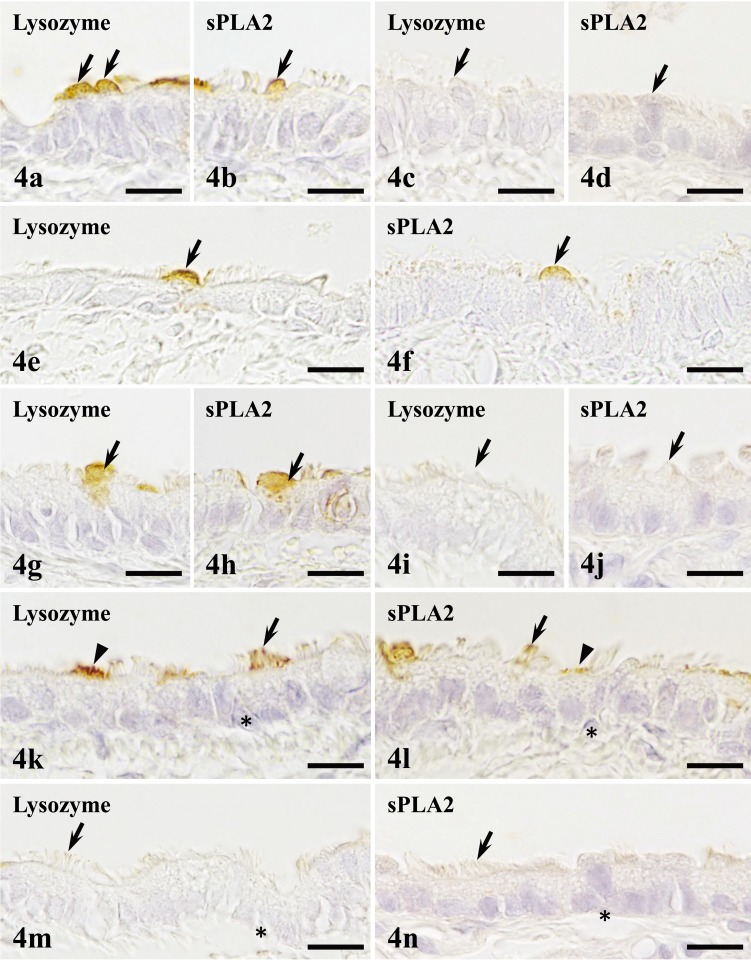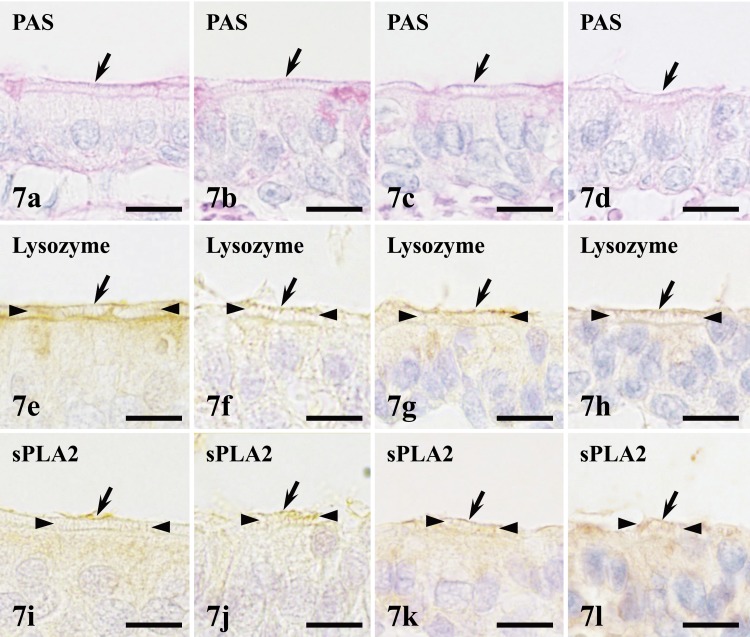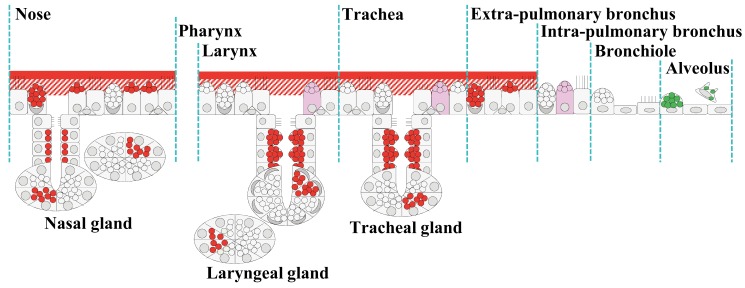Abstract
The host defense system with lysozyme and secretory phospholipase A2 (sPLA2) was immunohistochemically investigated in rat respiratory tract under healthy conditions. In the nasal epithelium, a large number of non-ciliated and non-microvillous cells (NC) and a small number of goblet cells (GC) were immunopositive for lysozyme and sPLA2. A few acinar cells and almost all epithelial cells of intercalated ducts were immunopositive for both bactericidal substances in the nasal glands. In the laryngeal and tracheal epithelia, few NC and GC were immunopositive for both bactericidal substances. In the laryngeal and tracheal glands, a few acinar cells and most ductal epithelial cells were immunopositive for both bactericidal substances. In extra-pulmonary bronchus, small numbers of NC and GC were immunopositive for lysozyme and sPLA2, whereas few NC and no GC were immunopositive in the intra-pulmonary bronchus. No secretory source of either bactericidal substance was located in the bronchioles. In the alveolus, many glandular epithelial cells and alveolar macrophages were immunopositive for lysozyme but immunonegative for sPLA2. Moreover, lysozyme and sPLA2 were detected in the mucus layer and in the periciliary layer from the nose to the extra-pulmonary bronchus. These findings suggest that secretory sources of lysozyme and sPLA2 are distributed in almost all the respiratory tract. Their secretory products are probably transported to the pharynx and contribute to form the first line of defense against inhaled bacteria throughout the respiratory tract.
Keywords: immunohistochemistry, lysozyme, rat, respiratory tract, sPLA2
Through incessant inspiration, respiratory organs of animals including human inhale foreign substances. Inhaled foreign substances larger than 3 µm in diameter are deposited mainly in the cranial airway, with the rest being deposited in the caudal airway in human [12, 16, 23], mouse, hamster, rabbit [29], guinea pig and rat [29, 31]. Minute foreign substances 0.3–2 µm in diameter are deposited throughout the respiratory tract in human [12, 16, 23], mouse, hamster, rat, guinea pig and rabbit [29]. Moreover, inhaled fibrous substances 0.2–1.5 µm in diameter and 2–60 µm in length are also deposited throughout the respiratory tract of rat [9, 25]. The bacterial diameters are generally in 0.2–2 µm; the minimal diameter is 0.1 µm in Treponema, Mycoplasma and Haemobartonella, and a maximal diameter is 10 µm in Achromatium and Macromonas. Some bacteria, such as Lactobacillus, have a long rod shape 0.5–1.2 µm in diameter and 10 µm in length [17]. Inhaled bacteria of these dimensions can be reached and be deposited throughout the respiratory tract.
Mucosal epithelium from the nose to the bronchus is covered by two liquid layers: an outer “mucus layer” and an inner “periciliary layer” [24]. When inhaled particles are deposited on the mucus layer on the epithelium from the nose to the bronchus, they are accumulated by transportation of the mucus layer toward the pharynx. The transportation of the mucus is generated by the beating of cilia of epithelial cells [15]. The accumulated mucus layer is finally swallowed or eliminated by coughing or sneeze reflex [15]. In contrast to the airway from the nose to the bronchus, the most caudal portion of the airway possesses a periciliary layer but not a mucus layer. Therefore, inhaled particles adhering to the periciliary layer are engulfed by alveolar macrophages. The elimination process, except for that in the most caudal portion, is assumed to take a long time until complete expulsion from the respiratory tract is achieved. The duration of the elimination process might lead to the proliferation of, or the infection with inhaled bacteria. In fact, bacteria usually settle on the cranial portion of the airway under healthy conditions in human [14, 22], dog [7], rat [27], pig, bovine and chicken [26]. However, the caudal respiratory tracts of human and rat are maintained mostly sterile [21, 27]. Therefore, it is assumed that the respiratory tract contains an additional host defense system which actually prevents proliferation of bacteria.
Immunoglobulins, complements and bactericidal substances are contained in nasal [5, 8] and broncho-alveolar lavage fluids [1, 6] from healthy human. Nasal lavage fluids from healthy human and rat contain lysozyme [8, 30] and secretory phospholipase A2 (sPLA2) [2]. Broncho-alveolar lavage fluid also contains lysozyme [1]. The secretory sources of lysozyme or sPLA2 have been immunohistochemically observed in nasal glands of human [11, 34] and guinea pig [19], as well as in human trachea or bronchus [13] and rat lung [30]. However, the total secretory system of lysozyme and sPLA2 in the respiratory tract has never been clarified. In addition, the localization of lysozyme and sPLA2 has never been clarified in the mucus layer and in the periciliary layer, because the preservation of the mucus layer as a first line of defense is very difficult in the chemically fixed specimens under light microscopic observation. In this study, the secretory sources and the distribution of secreted lysozyme and sPLA2 are investigated throughout rat respiratory tract under healthy conditions.
MATERIALS AND METHODS
Animals
Eight male specific-pathogen-free Wistar rats aged 7 weeks and derived from different mothers (Japan SLC Inc., Hamamatsu, Japan) were maintained under specific-pathogen-free conditions in individual ventilated cages (Sealsafe plus; Tecniplast Japan, Tokyo, Japan) with controlled temperature (23 ± 1°C) and humidity (50%) on a 12-hr light/dark cycle at the Life-Science Laboratory of Kobe University. All animals were permitted free access to water and food (Lab R-A2; Japan SLC Inc.). Clinical and pathological examinations in all animals confirmed no sign of disorder. The experiments were approved by the Institutional Animal Care and Use Committee (Permission number: 25-06-01) and were carried out according to the Kobe University Animal Experimentation Regulations.
Tissue preparation
All rats were euthanized with an intraperitoneally injected overdose of pentobarbital sodium (Kyoritsu Seiyaku Corp., Tokyo, Japan).
To identify secretory sources of lysozyme and sPLA2, five rats were transcardially perfused with 4% paraformaldehyde (PFA) in 0.1 M phosphate buffer at 38°C. Immediately after perfusion, the respiratory region of the nasal mucosa and larynx, trachea, extra-pulmonary bronchus and lung with intra-pulmonary bronchus were removed and cut into small blocks. All tissue blocks were immersion-fixed in 4% PFA for 6 hr at 4°C. The blocks were dehydrated and embedded in paraffin by routine methods.
To determine the localization of lysozyme and sPLA2 in both the mucus layer and the periciliary layer, nasal mucosa, larynx, trachea and extra-pulmonary bronchus were removed from 3 rats after euthanasia. The tissues were cut into small blocks and immediately and softly immersed in Carnoy’s fluid with minimal movement of the liquid for 1 hr at −30°C. After fixation, the tissue blocks were dehydrated and embedded in paraffin.
Sections 4 µm thick were cut and mounted on slide glasses precoated with 0.2% 3-aminopropyltriethoxysilane (Shin-Etsu Chemical Co., Tokyo, Japan) and stored at 4°C until use.
Immunohistochemistry
Antigens were detected using the indirect method of enzyme immunohistochemistry. Briefly, deparaffinized sections were immersed in absolute methanol and 0.5% H2O2 each for 30 min to remove endogenous peroxidase activity. The sections were then rinsed three times with 0.05% Tween-added 0.01 M phosphate buffered saline (TPBS pH 7.4) after all preparation steps in order to remove any reagent residues. Following blocking with Blocking One Histo (Nacalai Tesque Inc., Kyoto, Japan) for 1 hr at room temperature (r.t.), the sections were reacted with anti lysozyme goat IgG (C-19, diluted at 1:400 for PFA-fixed tissue, 1:100 for Carnoy’s fluid-fixed tissue) or anti sPLA2 (M-18, diluted at 1:400 for PFA-fixed tissue, 1:200 for Carnoy’s fluid-fixed tissue) goat IgG (Santa Cruz Biotechnology Inc., Santa Cruz, CA, U.S.A.) for 18 hr at 6°C. The antibody specificity for rat lysozyme or sPLA2 is described in the manufacturer’s respective specification forms (lysozyme, sc-27958; sPLA2, sc-14472). Then, the sections were incubated with horseradish peroxidase-conjugated anti goat IgG mouse IgG (AP186P) (diluted at 1:200; Chemicon International Inc., Billerica, MA, U.S.A.) for 1 hr at r.t. After rinsing with TPBS, the sections were incubated with 3,3′-diaminobenzidine (Dojindo Laboratories, Mashiki, Japan) containing 0.03% H2O2 and were counterstained with hematoxylin. Control sections were incubated with TPBS or non-immunized goat IgG instead of primary antibodies.
Polysaccharide staining
Periodic acid Schiff (PAS) reaction was conducted using Carnoy’s fluid-fixed tissues to detect the mucus layer.
RESULTS
Nasal mucosa
Ciliated epithelial cells were the largest cell population and goblet cells (GC), non-ciliated and non-microvillous epithelial cells (NC) and basal epithelial cells were found in small populations in the respiratory region of the nasal epithelium. GC occasionally formed clusters in the epithelium. In a large number of NC, the cytoplasm were immunopositive for both lysozyme and sPLA2, and the immunopositive intensities increased toward the apical membranes. In a small number of GC, secretory granules were immunopositive for both lysozyme and sPLA2. No immunopositivities for lysozyme and sPLA2 were detected in the cytoplasm of ciliated epithelial cells and basal epithelial cells. Both bactericidal substances were frequently detected on the tips or the entire length of cilia of ciliated epithelial cells (Fig. 1a and 1b).
Fig. 1.
The localization of lysozyme and sPLA2 in the nasal mucosa. In nasal epithelium, lysozyme and sPLA2 are immunopositive in the cytoplasm of NC (arrows in a and b), secretory granules of GC (large arrowheads in a and b) and cilia of ciliated epithelial cells (small arrowheads in a and b), but negative in cytoplasm of ciliated epithelial cells and basal epithelial cells (asterisks in a and b). In the nasal gland, lysozyme and sPLA2 are immunopositive in secretory granules of serous acinar cells (arrows in c and d) and intercalated ducts (arrows in e and f). Immunopositivities of lysozyme and sPLA2 are also visible on the luminal surface of cells of exocrine ducts (arrows in g and h) and luminal contents (large arrowheads in g and h). Bar=10 µm.
In nasal glands, lysozyme- and sPLA2-immunopositivities were detected in secretory granules in a few acinar cells and in almost all epithelial cells of intercalated ducts (Fig. 1c–f). Both immunopositivities were occasionally found on the apical surfaces of epithelial cells and in the luminal secretory products of the excretory ducts (Fig. 1g and 1h).
Laryngeal mucosa
Among NC which were the predominant cell population in the laryngeal epithelium, few were immunopositive for lysozyme and sPLA2. Most GC, which were rarely present, were immunonegative for lysozyme and sPLA2 (Fig. 2a–d). No immunopositivities for lysozyme and sPLA2 were detected in the cytoplasm of any ciliated epithelial cells, microvillous epithelial cells and basal epithelial cells. Both bactericidal substances were occasionally detected on the tips or the entire length of both cilia of ciliated epithelial cells and microvilli of microvillous cells (Fig. 2e and 2f).
Fig. 2.
The localization of lysozyme and sPLA2 in the laryngeal mucosa. In epithelium, lysozyme and sPLA2 are negative in cytoplasm of NC (arrows in a and b), GC (arrowheads in a and b), but a solitary NC immunopositive for lysozyme and sPLA2 is visible (arrows in c and d). Lysozyme and sPLA2 are immunonegative in cytoplasm of ciliated epithelial cells (arrows in e and f), microvillous cells (arrowheads in e and f) and basal epithelial cells (asterisks in e and f), but immunopositive in cilia of ciliated epithelial cells and microvilli of microvillous cells. In laryngeal glands, lysozyme and sPLA2 are immunopositive in mucous acinar cells (arrows in g and h), serous acinar cells (arrows in i and j) and epithelial cells (arrows in k and l) of glandular ducts and in luminal contents in glandular ducts (arrowheads in k and l). Bar=10 µm.
In laryngeal glands, immunopositivities for both bactericidal substances were detected in a few mucus acinar cells and serous acinar cells (Fig. 2g–j). Moreover, both bactericidal substances were detected in the cytoplasm of most glandular ducts and in the luminal contents (Fig. 2k and 2l).
Tracheal mucosa
In the tracheal epithelium, immunopositivities for lysozyme and sPLA2 were detected in few NC which were the predominant cell population and GC which were rare (Fig. 3a–d). No immunoreactivity for either bactericidal substance was detected in the cytoplasm of ciliated epithelial cells, microvillous epithelial cells and basal epithelial cells. The tips or the entire length of both cilia of many ciliated epithelial cells and microvilli of microvillous cells were immunopositive for lysozyme and sPLA2 (Fig. 3b, 3e and 3f).
Fig. 3.
The localization of lysozyme and sPLA2 in the tracheal mucosa. In epithelium, lysozyme and sPLA2 are immunonegative in cytoplasm of NC (arrows in a and b), GC (large arrowheads in a and b), but a solitary NC immunopositive for lysozyme and sPLA2 is visible (arrows in c and d). Lysozyme and sPLA2 are immunopositive in cilia or microvilli, but are negative in cytoplasm of ciliated epithelial cells (small arrowhead in b and arrow in e) and microvillous cells (large arrowheads in e and f) and basal epithelial cells (asterisks in e and f). In tracheal glands, lysozyme and sPLA2 are immunopositive in serous acinar cells (arrows in g and h), epithelial cells of glandular ducts (arrows in i and j) and luminal contents in glandular ducts (arrowheads in i and j). Bar=10 µm.
In the tracheal glands, immunoreactivities for both lysozyme and sPLA2 were detected in the cytoplasm of a few serous acinar cells (Fig. 3g and 3h) and detected in the cytoplasm of most epithelial cells of glandular ducts (Fig. 3i and 3j). The luminal contents were immunopositive for both bactericidal substances (Fig. 3i and 3j).
Extra- and intra-pulmonary bronchial mucosae
A small number of NC, which were the predominant cell population, were immunopositive for both bactericidal substances in the extra-pulmonary bronchial epithelium (Fig. 4a and 4b), whereas in the intra-pulmonary bronchial epithelium, extremely few NC, which were also the predominant cell population, were immunopositive (Fig. 4c–f). Both immunopositivities were occasionally detected in GC of the extra-pulmonary bronchial epithelium (Fig. 4g and 4h), but neither was detected in GC of the intra-pulmonary bronchial epithelium (Fig. 4i and 4j). Both bactericidal substances were immunonegative in cytoplasm of ciliated epithelial cells and basal epithelial cells in both bronchi (Fig. 4k–n) and in cytoplasm of microvillous epithelial cells in the extra-pulmonary bronchus (Fig. 4k and 4l). Both bactericidal substances were occasionally detected on the tips or the entire length of both cilia of ciliated epithelial cells and microvilli of microvillous cells in extra-pulmonary bronchus (Fig. 4k and 4l), whereas not detected in intra-pulmonary bronchus (Fig. 4m and 4n). No microvillous epithelial cells were present in intra-pulmonary bronchus. No exocrine gland was accompanied in the caudal part from extra-pulmonary bronchus.
Fig. 4.
The localization of lysozyme and sPLA2 in extra- and intra- pulmonary mucosa. Lysozyme and sPLA2 are immunopositive in cytoplasm of NC (arrows in a and b) in extra-pulmonary bronchus. In intra-pulmonary bronchus, NC are immunonegative for lysozyme and sPLA2 (arrows in c and d), but a solitary NC immunopositive for both bactericidal substances is visible (arrows in e and f). Lysozyme and sPLA2 are immunopositive in secretory granules of GC (arrows in g and h) in extra-pulmonary bronchus, but immunonegative in intra-pulmonary bronchus (arrows in i and j). In extra-pulmonary bronchus, lysozyme and sPLA2 are detected in cilia of ciliated epithelial cells (arrows in k and l) and microvilli of microvillous cells (arrowheads in k and l), but not in cytoplasm of ciliated epithelial cells, microvillous cells and basal epithelial cells (asterisks in k and l). In intra-pulmonary bronchus, lysozyme and sPLA2 are immunonegative in cytoplasm of ciliated epithelial cells (arrows in m and n) and basal epithelial cells (asterisks in m and n). Bar=10 µm.
Bronchiolar epithelium
Lysozyme and sPLA2 were not detected in the cytoplasm of NC, ciliated epithelial cells and Clara cells in the bronchiole (Fig. 5a and 5b).
Fig. 5.
No immunopositivities for lysozyme and sPLA2 are detected in cytoplasm of NC (arrows in a and b), ciliated epithelial cells (large arrowheads in a and b) and Clara cells (small arrowheads in a and b) in bronchiolar epithelium. Bar=10 µm.
Alveolar epithelium
Strong immunopositivities for lysozyme were frequently detected in the cytoplasm of granular alveolar cells and alveolar macrophages (Fig. 6a and 6b). Immunopositive reactions for lysozyme were also detected in squamous alveolar cells (Fig. 6a). However, the strict localization of immunopositive reaction products in the cytoplasm or on the cell membranes could not be determined because of the extremely thin cytoplasm. No immunopositivities for sPLA2 were detected in granular and squamous alveolar cells and alveolar macrophages (Fig. 6c and 6d).
Fig. 6.
The localization of lysozyme and sPLA2 in alveoli. Lysozyme is immunopositive in granular alveolar cell (arrow in a), squamous alveolar cell (arrowhead in a) and alveolar macrophage (arrow in b). sPLA2 is immunonegative in granular alveolar cell (arrow in c), squamous alveolar cell (arrowhead in c) and alveolar macrophage (arrow in d). Bar=10 µm.
Mucus layer and periciliary layer on epithelial cells
From specimens with Carnoy’s fluid fixation, the mucus layer was clearly identified as a positive line by PAS-reaction (Fig. 7a–d). The mucus layer was immunopositive for both lysozyme and sPLA2 from the nasal to extra-pulmonary bronchial epithelium (Fig. 7e–l). The anatomical situation of the mucus layer corresponded with the level of the tips of cilia in specimens with PFA fixation. In the periciliary layer, which anatomically corresponded with the level of the cilia except for the tips, lysozyme and sPLA2 were immunopositive on the cilia of a part of ciliated epithelial cell population from the nasal to extra-pulmonary bronchial epithelium (Fig. 7e–l).
Fig. 7.
The localization of lysozyme and sPLA2 in the mucus layer and the periciliary layer of Carnoy’s fluid-fixed tissue. PAS-positive mucus layer (arrows) are visible on the periciliary layer of nasal (a), laryngeal (b), tracheal (c) and extra-pulmonary bronchial (d) epithelia. Lysozyme and sPLA2 are detected in the mucus layer (arrows) and periciliary layer (between arrowheads) in nasal (e and i), laryngeal (f and j), tracheal (g and k) and extra-pulmonary bronchial (h and l) epithelia. Bar=10 µm.
Negative controls
In negative controls using normal goat IgG instead of the primary antibodies, no immunopositive reaction was detected in PFA-fixed specimens from 4 animals, whereas immunopositive reactions were weakly or moderately detected only in cilia of few ciliated epithelial cells in the specimen from 1 animal. In all specimens with Carnoy’s fluid fixation, weakly immunopositive reactions were detected only in cytoplasm of ciliated epithelial cells. No immunopositive reactions were detected in the negative control specimens with either fixation using TPBS instead of primary antibodies. The individual immunopositivities described in the results were estimated by subtracting the immunopositivities in the negative controls.
DISCUSSION
Lysozyme and sPLA2 have bactericidal effects against both Gram-positive and -negative bacteria [10, 28, 36]. Lysozyme is contained in the lavage fluids from the cranial and caudal airways [1, 8, 30]. sPLA2 is also contained in the lavage fluid from the cranial airway [2]. In this study, secretory cells of lysozyme and sPLA2 were mainly located in the nasal epithelium, the nasal glands, the laryngeal glands, the tracheal glands and the extra-pulmonary bronchial epithelium. In alveoli, secretory cells of lysozyme, but not sPLA2, were located in the epithelium. In comparison with specimens with Carnoy’s fluid fixation and specimens with PFA fixation, the anatomical situation of the mucus layer corresponds with the level of the tips of cilia. The periciliary layer corresponds with the level of the cilia except for the tips. From specimens with both fixations, lysozyme and sPLA2 were detected in both the mucus and periciliary layers from the nose to the extra-pulmonary bronchus (summarized in Fig. 8). These findings suggest that the secretory cells and their secretory products, lysozyme and sPLA2, form the line of first defense against inhaled bacteria throughout almost all portions of the respiratory tract under healthy conditions.
Fig. 8.
A schema of the distribution of secretory cells of lysozyme and sPLA2 in rat respiratory tract under healthy conditions. Cells with red granules represent secretory cells of both lysozyme and sPLA2. Cells with green granules represent lysozyme-immunopositive granules in a granular alveolar cell and an alveolar macrophage. Pink cells represent lysozyme- and sPLA2-positive NC which were rarely located in epithelium. Red band and red-striped band represent lysozyme and sPLA2 double-immunopositive mucus layer and periciliary layer on the epithelium, respectively.
Laboratory animals usually live in contact with their feces in a rearing environment. Especially, rats eat their feces [33], which contain various Gram-positive and -negative bacteria [4]. Therefore, it is speculated that dust containing both Gram-positive and -negative bacteria derived from dried feces, and that the bacteria are deposited on the mucus layer especially in the cranial portion of the respiratory tract. Moreover, the nose is considered to be the settlement site of bacteria in rat [27], dog [7], pig, bovine, chicken [26] and human [14, 22]. In this study, secretory cells immunopositive for lysozyme and sPLA2 were slightly richer in nasal mucosa than in the airway caudal from larynx, although a large number of the secretory cells, such as goblet cells and acinar cells of the nasal glands, were immunonegative for lysozyme and sPLA2 in the nasal mucosa. On the basis of these findings, relatively rich secretory cells of lysozyme and sPLA2 were assigned to the nasal mucosa against both incessant inhaled bacteria and settled bacteria in comparison with other respiratory mucosa under healthy conditions. Considering that indigenous bacteria in the nose possess beneficial effect on the host, such as bacterial interference against pathogenic bacteria [20, 22], the presence of secretory cells immunonegative for lysozyme and sPLA2 might indicate that indigenous bacteria are somewhat allowed to settle on the nasal mucosa. In contrast to the nasal mucosa, comparatively fewer secretory cells of lysozyme and sPLA2 in the airway caudal from the larynx are probably sufficient for host defense against bacteria under healthy conditions, because culturable bacteria are not always detected in the caudal airway of rat [27].
The lysozyme concentration in the nasal lavage fluid rises under rhinovirus infection [18]. In patients with chronic bronchitis, the concentrations of lysozyme and lactoferrin in broncho-alveolar lavage fluids are higher than in healthy human [32]. The concentration of lysozyme in exhaled breath condensate is higher in patients with asthma than in healthy human [3]. Thus, the secretion of bactericidal substances is increased in various respiratory infections and diseases. In this study, secretory cells with no immunopositivity for lysozyme and sPLA2 were located in the epithelium from the nose to the alveolus and in the exocrine glands from nose to trachea under healthy conditions. This finding indicates that all respiratory mucosae possess the additional ability to secrete more bactericidal substances, so that the secretory defense system might be able to respond immediately to the respiratory infections or diseases.
Except for lysozyme and sPLA2, immunoglobulins, complements, lactoferrin, defensins and cathelicidins are contained in nasal [5, 8] and broncho-alveolar lavage fluid [1, 6]. Moreover, surfactant proteins are contained in bronchi-alveolar lavage fluids [6, 35]. These secretory substances are assumed to contribute to the host defense against bacterial infection in the respiratory tract. However, the overall structures of the secretory defense systems have not been clarified yet. Therefore, further investigations into secretory defense systems in the respiratory organs are needed in order to understand the total host defense system in those organs.
Acknowledgments
This work was supported by JSPS KAKENHI grant number 15K07766.
REFERENCES
- 1.Agerberth B., Grunewald J., Castaños-Velez E., Olsson B., Jörnvall H., Wigzell H., Eklund A., Gudmundsson G. H.1999. Antibacterial components in bronchoalveolar lavage fluid from healthy individuals and sarcoidosis patients. Am. J. Respir. Crit. Care Med. 160: 283–290. doi: 10.1164/ajrccm.160.1.9807041 [DOI] [PubMed] [Google Scholar]
- 2.Aho H. J., Grénman R., Sipilä J., Peuravuori H., Hartikainen J., Nevalainen T. J.1997. Group II phospholipase A2 in nasal fluid, mucosa and paranasal sinuses. Acta Otolaryngol. 117: 860–863. doi: 10.3109/00016489709114215 [DOI] [PubMed] [Google Scholar]
- 3.Bloemen K., Van Den Heuvel R., Govarts E., Hooyberghs J., Nelen V., Witters E., Desager K., Schoeters G.2011. A new approach to study exhaled proteins as potential biomarkers for asthma. Clin. Exp. Allergy 41: 346–356. doi: 10.1111/j.1365-2222.2010.03638.x [DOI] [PubMed] [Google Scholar]
- 4.Brooks S. P. J., McAllister M., Sandoz M., Kalmokoff M. L.2003. Culture-independent phylogenetic analysis of the faecal flora of the rat. Can. J. Microbiol. 49: 589–601. doi: 10.1139/w03-075 [DOI] [PubMed] [Google Scholar]
- 5.Casado B., Pannell L. K., Iadarola P., Baraniuk J. N.2005. Identification of human nasal mucous proteins using proteomics. Proteomics 5: 2949–2959. doi: 10.1002/pmic.200401172 [DOI] [PubMed] [Google Scholar]
- 6.Chen J., Ryu S., Gharib S. A., Goodlett D. R., Schnapp L. M.2008. Exploration of the normal human bronchoalveolar lavage fluid proteome. Proteomics Clin. Appl. 2: 585–595. doi: 10.1002/prca.200780006 [DOI] [PMC free article] [PubMed] [Google Scholar]
- 7.Clapper W. E., Meade G. H.1963. Normal flora of the nose, throat, and lower intestine of dogs. J. Bacteriol. 85: 643–648. [DOI] [PMC free article] [PubMed] [Google Scholar]
- 8.Cole A. M., Dewan P., Ganz T.1999. Innate antimicrobial activity of nasal secretions. Infect. Immun. 67: 3267–3275. [DOI] [PMC free article] [PubMed] [Google Scholar]
- 9.Evans J. C., Evans R. J., Holmes A., Hounam R. F., Jones D. M., Morgan A., Walsh M.1973. Studies on the deposition of inhaled fibrous material in the respiratory tract of the rat and its subsequent clearance using radioactive tracer techniques. 1. UICC crocidolite asbestos. Environ. Res. 6: 180–201. doi: 10.1016/0013-9351(73)90032-7 [DOI] [PubMed] [Google Scholar]
- 10.Fleming A.1922. On a remarkable bacteriolytic element found in tissues and secretions. Proc. R. Soc. Lond. B Biol. Sci. 93: 306–317. doi: 10.1098/rspb.1922.0023 [DOI] [Google Scholar]
- 11.Franken C., Meijer C. J. L. M., Dijkman J. H.1989. Tissue distribution of antileukoprotease and lysozyme in humans. J. Histochem. Cytochem. 37: 493–498. doi: 10.1177/37.4.2926127 [DOI] [PubMed] [Google Scholar]
- 12.Fry F. A., Black A.1973. Regional deposition and clearance of particles in the human nose. J. Aerosol Sci. 4: 113–124. doi: 10.1016/0021-8502(73)90063-3 [DOI] [Google Scholar]
- 13.Girod S., Fuchey C., Galabert C., Lebonvallet S., Bonnet N., Ploton D., Puchelle E.1991. Identification of phospholipids in secretory granules of human submucosal gland respiratory cells. J. Histochem. Cytochem. 39: 193–198. doi: 10.1177/39.2.1987263 [DOI] [PubMed] [Google Scholar]
- 14.Glück U., Gebbers J. O.2000. The nose as bacterial reservoir: important differences between the vestibule and cavity. Laryngoscope 110: 426–428. doi: 10.1097/00005537-200003000-00019 [DOI] [PubMed] [Google Scholar]
- 15.Harada R. N., Repine J. E.1985. Pulmonary host defense mechanisms. Chest 87: 247–252. doi: 10.1378/chest.87.2.247 [DOI] [PubMed] [Google Scholar]
- 16.Heyder J., Gebhart J., Rudolf G., Schiller C. F., Stahlhofen W.1986. Deposition of particles in the human respiratory tract in the size range 0.005–15 µm. J. Aerosol Sci. 17: 811–825. doi: 10.1016/0021-8502(86)90035-2 [DOI] [Google Scholar]
- 17.Holt J. G., Krieg N. R., Sneath P. H. A., Staley J. T., Williams S. T.1994. Bergey’s Manual of Determinative Bacteriology. 9th ed., Williams and Wilkins., Baltimore. [Google Scholar]
- 18.Igarashi Y., Skoner D. P., Doyle W. J., White M. V., Fireman P., Kaliner M. A.1993. Analysis of nasal secretions during experimental rhinovirus upper respiratory infections. J. Allergy Clin. Immunol. 92: 722–731. doi: 10.1016/0091-6749(93)90016-9 [DOI] [PubMed] [Google Scholar]
- 19.Ishige T., Okamura H. O., Kitamura K.2008. Immunohistochemical localization of phospholipase A2 in the guinea pig nasal mucosa. J. Med. Dent. Sci. 55: 29–32. [PubMed] [Google Scholar]
- 20.Iwase T., Uehara Y., Shinji H., Tajima A., Seo H., Takada K., Agata T., Mizunoe Y.2010. Staphylococcus epidermidis Esp inhibits Staphylococcus aureus biofilm formation and nasal colonization. Nature 465: 346–349. doi: 10.1038/nature09074 [DOI] [PubMed] [Google Scholar]
- 21.Laurenzi G. A., Potter R. T., Kass E. H.1961. Bacteriologic flora of the lower respiratory tract. N. Engl. J. Med. 265: 1273–1278. doi: 10.1056/NEJM196112282652601 [DOI] [PubMed] [Google Scholar]
- 22.Lina G., Boutite F., Tristan A., Bes M., Etienne J., Vandenesch F.2003. Bacterial competition for human nasal cavity colonization: role of Staphylococcal agr alleles. Appl. Environ. Microbiol. 69: 18–23. doi: 10.1128/AEM.69.1.18-23.2003 [DOI] [PMC free article] [PubMed] [Google Scholar]
- 23.Lippmann M.1970. Deposition and clearance of inhaled particles in the human nose. Ann. Otol. Rhinol. Laryngol. 79: 519–528. doi: 10.1177/000348947007900314 [DOI] [PubMed] [Google Scholar]
- 24.Matsui H., Randell S. H., Peretti S. W., Davis C. W., Boucher R. C.1998. Coordinated clearance of periciliary liquid and mucus from airway surfaces. J. Clin. Invest. 102: 1125–1131. doi: 10.1172/JCI2687 [DOI] [PMC free article] [PubMed] [Google Scholar]
- 25.Morgan A., Black A., Evans N., Holmes A., Pritchard J. N.1980. Deposition of sized glass fibres in the respiratory tract of the rat. Ann. Occup. Hyg. 23: 353–366. [DOI] [PubMed] [Google Scholar]
- 26.Nakano C., Shimizu A., Kawano J., Kitai S., Kitagawa H.2008. Distribution and characteristics of enterotoxigenic and methicillin-resistant Staphylococcus aureus in the nares of humans and animals. Jpn. J. Food Microbiol. 25: 83–88(in Japanese with English abstract). doi: 10.5803/jsfm.25.83 [DOI] [Google Scholar]
- 27.Pesti L., Wiseman R. F., Bruckner G., Gordon H. A.1984. Effects of tobacco smoke inhalation on the tracheo-bronchial microflora of rats. Comp. Immunol. Microbiol. Infect. Dis. 7: 75–80. doi: 10.1016/0147-9571(84)90001-8 [DOI] [PubMed] [Google Scholar]
- 28.Peterson R. G., Hartsell S. E.1955. The lysozyme spectrum of the gram-negative bacteria. J. Infect. Dis. 96: 75–81. doi: 10.1093/infdis/96.1.75 [DOI] [PubMed] [Google Scholar]
- 29.Raabe O. G., Al-Bayati M. A., Teague S. V., Rasolt A.1988. Regional deposition of inhaled monodisperse coarse and fine aerosol particles in small laboratory animals. Ann. Occup. Hyg. 32Suppl. 1: 53–63. [Google Scholar]
- 30.Singh G., Katyal S. L., Brown W. E., Collins D. L., Mason R. J.1988. Pulmonary lysozyme--a secretory protein of type II pneumocytes in the rat. Am. Rev. Respir. Dis. 138: 1261–1267. doi: 10.1164/ajrccm/138.5.1261 [DOI] [PubMed] [Google Scholar]
- 31.Snipes M. B., Olson T. R., Yeh H. C.1988. Deposition and retention patterns for 3-, 9-, and 15-micron latex microspheres inhaled by rats and guinea pigs. Exp. Lung Res. 14: 37–50. doi: 10.3109/01902148809062849 [DOI] [PubMed] [Google Scholar]
- 32.Thompson A. B., Bohling T., Payvandi F., Rennard S. I.1990. Lower respiratory tract lactoferrin and lysozyme arise primarily in the airways and are elevated in association with chronic bronchitis. J. Lab. Clin. Med. 115: 148–158. [PubMed] [Google Scholar]
- 33.Torrallardona D., Harris C. I., Fuller M. F.1996. Microbial amino acid synthesis and utilization in rats: the role of coprophagy. Br. J. Nutr. 76: 701–709. doi: 10.1079/BJN19960077 [DOI] [PubMed] [Google Scholar]
- 34.van den Oord J. J., De Wolf-Peeters C., Desmet V.1982. Immunohistochemical localization of lysozyme in the nasal respiratory mucosa. Arch. Otorhinolaryngol. 237: 1–5. doi: 10.1007/BF00453710 [DOI] [Google Scholar]
- 35.von Bredow C., Birrer P., Griese M.2001. Surfactant protein A and other bronchoalveolar lavage fluid proteins are altered in cystic fibrosis. Eur. Respir. J. 17: 716–722. doi: 10.1183/09031936.01.17407160 [DOI] [PubMed] [Google Scholar]
- 36.Weinrauch Y., Elsbach P., Madsen L. M., Foreman A., Weiss J.1996. The potent anti-Staphylococcus aureus activity of a sterile rabbit inflammatory fluid is due to a 14-kD phospholipase A2. J. Clin. Invest. 97: 250–257. doi: 10.1172/JCI118399 [DOI] [PMC free article] [PubMed] [Google Scholar]



